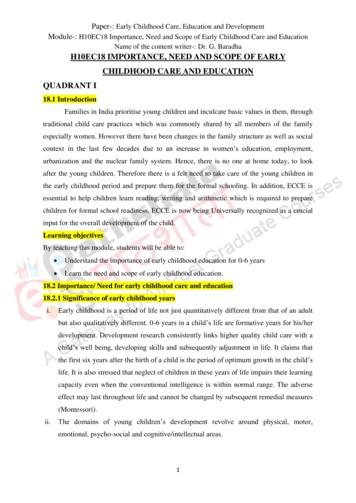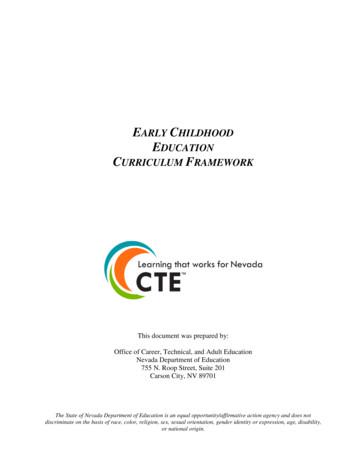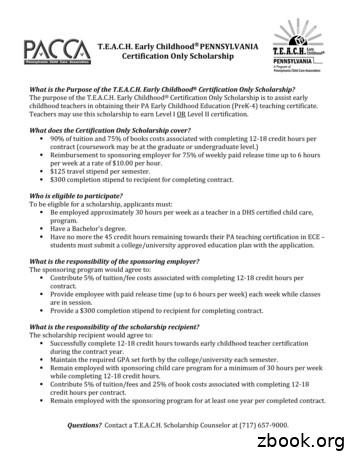Early Childhood Education And Care Funding And Performance .
Early Childhood Education and Care Fundingand Performance UpdateDr. Jon Courtney, Deputy DirectorKelly Klundt, Principal AnalystDawn Iglesias, Chief EconomistLegislative Finance CommitteeSeptember 22, 20201
New Mexico’s Early Childhood System2
New Mexico’s Early Childhood PopulationEstimated Population Under 5 The 0-5 population has declined20% over the last decade In 2019, 3 of every 4 births in NMwere supported by MedicaidNew Mexico Estimated PopulationBelow Age 5, 2009-2019New Mexico Births Supported byMedicaid (2019)160,000140,000NonMedicaidBirths, 26%120,000100,00080,00060,00040,000MedicaidBirths, 74%20,0000Source: LFC anaysis of U.S. Census Bureau data.Source: DOH3
Child OutcomesSAFEChild DeathRate: Abuse orNeglect2018Rate of ChildMaltreatmentRate of FosterCare 10%Per 100,000childrenPer 1,000 childrenPer 1,000 childrenU.S. 2.39U.S. – Better201910.4%ACFACFInfant MortalityLow Birth WeightImmunizationRateEarly Access toPrenatal Care20182018201820186.09.1%76.7%64%HEALTHYPer 1,000 children2,088 childrenU.S. – 6.4 (2018)U.S. – 8.3% (2018)BetterBetter2017Source:U.S. Std– 5.4%6.2CDC20179.5%DOHACFU.S. – 70.4%(2018)Better201772%CYFD/NCANDS23,708 childrenU.S. – 77.5% (2018)No Change2017DOH64%DOHOther outcomes related to education and school readiness available on the LFC website ly Childhood And ly%20Childhood.pdf4
Education Outcomes: New Mexico At-Risk ChildrenStart Behind And Often Stay Behind Their PeersPast LFC Report Findings: Summary Most NM schools provide oneyear of academic growth. However, 80 percent of at-riskchildren start school behindtheir peers. Many children do not makethat lost ground. COVID is expected toexacerbate the achievementgap by up to a year impactingyoungest children the most.Higher IncomeGrade Level ProficiencySources: LFC 2017 Longitudinal Student Performance: https://tinyurl.com/LFC-2017-EDLFC 2020 Learning Loss due to COVID: https://tinyurl.com/LFC-2020-Learning-LossLower Income
New Mexico Early Childhood Education and CareFunding 500RecurringEarly Childhood FundingHistoryFY12-FY21(in millions) The New Mexico Legislature has significantlyincreased early childhood education and carefunding since state fiscal year 2012. Childcare Assistance, Early Prekindergarten,Prekindergarten, and Home-Visiting have beenparticular focuses of the Legislature for increasedfunding, even in years of financial constraint. Since FY15 early childhood funding has increased103 percent. This is not including increases to otherrelated early care support programs such as EarlyHead Start, Head Start, and WIC. Early Head Start and Head Start include anadditional estimated 72.6 million and WIC 43million in addition to the funding shown chart to theleft. 450 400 350 300 250 200 150 100 -FY12FY13FY14FY15FY16FY17FY18FY19FY20FY21 50FITEarly LiteracyK-5 PlusPrekindergartenHome VisitingChild Care Assistance6
New Mexico’s Early Childhood System Funding, Capacity, Performance of– PreK– Childcare Assistance– Home Visiting– Early Head Start and Head Start– K-5 Plus Much of this research was done pre-COVID.7
PrekindergartenEarly education program for 3- and 4-year-oldsFY21 Operating Budget: 100 million FY21 Estimated Capacity: 13,386Graduation RateNew Mexico 2019 HighSchool Graduation RateFor Lower-IncomeStudents – 11 percent increase in graduation rate for Englishlearners and lower-income participants– Improved reading and math scores from K through11th grades– 50 percent reduction in grade retention– 25 percent reduction in chronic absenteeism– Higher rate of exiting special education– 6 to 1 ROI using the NM Results First : Courtney et al. (in preparation)NIEER: Four year study found impact onlanguage, literacy, & math estimating a 6 to 1ROI.LFC: Numerous studies have found benefitsassociated with participation including During school closures PreK instruction waslimited to 30 minutes and national research onremote learning shows it is not as effective.8
Childcare AssistanceA subsidy program implemented for families with children 6 weeks to 13 whose families up to 200 percent ofthe federal poverty level and who work or attend training and education programsFY21 Operating Budget: 158.4millionFY21 Estimated Capacity: 22,000 permonth 2019 LFC evaluation found childcare participantssaw the following benefits:– Increased family income ( 3,500)– Increased well-child visits– Increased dental visits Some evidence of impact on school readiness inKindergarten (CCPI, LFC studies) Significant investments in quality ( 65m):– Over a 100% increase in reimbursement rates forsome age groups (infants) since 2012– However, to date no research has found evidenceof better outcomes with higher quality in NM. Childcare is also supporting hybrid learning forworking parentsLFC 2019 Childcare Report https://tinyurl.com/LFCChildcare20199
Home VisitingMultiple programs (e.g. Nurse Family Partnerships, Parents as Teachers) dedicated to intensive parent educationFY21 Operating Budget: 34.2* million*up to 9 million could be leveraged from Medicaidhome visiting pilotFY21 Estimated Capacity: 3,887 notincluding Medicaid pilotPercent accessing careNM Mothers AccessingPrenatal Care In 1st Statewide NM has several evidence-based/promising HVmodels including Nurse Family Partnership,Parents as Teachers, and First Born Generally speaking home visiting programshave positive impacts although type andmagnitude of impact vary by program. Nationally home visiting programs havedemonstrated impacts of improved childdevelopment, health, reduced childmaltreatment among others. UNM’s CCPI has found home visitingparticipation is associated with improved wellchild visits and access to prenatal careSource: UNM CCPIAnnual Home Visiting Report: ons/FY19HVReport.pdf10
Early Head Start (EHS) and Head Start (HS)Federally funded programs to promote school readiness of children under the age of 5 by enhancing theircognitive, social, and emotional development.FY20 Operating Budget: 72.6 millionFY20 Estimated Capacity: 7,390 slotsPercentage of teachers meeting standardPercentage of Head Startclassroom teachers meeting federalcredential requirements (2019)80%70%60%50%Federal Standard 50%40%30%20%10%0%New MexicoNational The What Works Clearinghouse (WWC)rates EHS and HS as promising. Research indicates that EHS can impactsafety and child well being outcomes(22 NM programs) Research indicates HS can impactstudent achievement and development(29 NM programs) Federal requirements call for 50% of HSteachers to have a relevant BA degree.Source: UNM CCPI11
K-5 Plus Extended YearAn extended school year program for kindergarten through 5th grade students aimed at improving timeon task which has been shown to impact student learningFY21 Operating Budget: 79.9 millionFY21 Estimated Capacity: 64,000*However only 16,000 slots applied for Utah State showed a significantimpact of K-3 Plus on studentachievement when the programwas run to fidelity. LFC research confirms Utah Statefindings regarding impact andimportance of fidelity. A 2020 LFC Policy Spotlight reportedthat PED cancelled 2020 summer K5 plus programs despite somedistricts (including APS) having plansin place to deliver content remotely.12
Stacking of Programs It is unlikely that oneprogram alone can close theachievement gap. Promising outcomes fromstacking of programs butmore research is needed.– 2017 Early ChildhoodAccountability Report:Showed a narrowing ofachievement gap for PreKAND K3 Plus participants– 2020 PreK Report: Betteroutcomes for children whoparticipated in 3yo PreK AND4yo PreK13
Early Childhood Education and Care CapacityEstimated NM Care and Education Funded Services By Age (FY21)Total re (2019)AIAN Early Head Start (2017)Early Head Start (2017)AIAN Head Start (2017)Head Start (2017)21st Century Grant (2018)PreK (2020)Mics. Preschool (2018)3/4 DD (2018)Births80 PercentFigures include 2021 funded slots where possible, otherwise most recent data available used.Sources: Early Head Start, Head Start: ECLCK PIR report; Others: LFC14
Capacity and Coordination Significant issues:– LFC found continuedevidence of competitionamong 4 year old programssuch that some marketsbecome oversaturated andprograms potentially losefunding.15
16
LFC’s Legislating for Results Framework:Evidence-Based Policy and BudgetingBenefitsto TaxPayersTotalBenefitsTotalCostsBenefits– CostsBenefit toCost Ratio(Return onInvestment)Home Visiting: Nurse FamilyPartnership 9,868 28,789 2,967 25,822 9.70Prekindergarten 16,362 40,743 7,000 33,743 5.82Head Start 7,167 22,452 8,564 13,888 2.62Home Visiting: Parents as Teachers 2,282 4,561 3,137 1,595 1.54Home Visiting: Other 2,210 4,419 2,970 1,449 1.49K3 Plus 1,535 6,122 4,562 1,560 1.34Childcare* 683 3,092 6,532 3,441 0.47Early Head Start 2,844 2,375 12,042 9,667 0.20*Childcare return on investment can be lower depending upon the star level.Source: LFC analysis using the Pew MacArthur Results First Model.New Mexico Results First: rst-initiative-in-new-mexico17
Early Childhood Education andCare Trust Fund House Bill 83 in the 2020 session created an early childhood trust fund to capture volatile windfall oil and gas revenuesSimultaneously provides a stable source of funding for early childhood programs and increases general fund revenue stabilityAt the end of FY20, the trust was endowed with 300 millionThe trust fund has two potential revenue streams to capture windfall oil and gas revenues: Bonus and royalty payments for production on federal lands (federal mineral leasing payments) Oil and gas emergency school tax (when reserves exceed 25% of recurring appropriations) Based on the December 2019 revenue estimate, the fund had the potential to receive over 575 million in distributions fromFY21-FY24; however, after the recent oil price collapse, oil and gas revenue distributions to the fund in the next few yearsappears unlikely.18
For More Information http://www.nmlegis.gov/lcs/lfc/lfcdefault.aspx19
Since FY15 early childhood funding has increased 103 percent. This is not including increases to other related early care support programs such as Early Head Start, Head Start, and WIC. Early Head Start and Head Start include an additional estimated 72.6 million and WIC 43 million in addition to the funding shown chart to the left. 6 - 50
Understand the importance of early childhood education for 0-6 years Learn the need and scope of early childhood education. 18.2 Importance/ Need for early childhood care and education 18.2.1 Significance of early childhood years i. Early childhood is a period of life not just quantitatively different from that of an adult
Early Childhood Care, Development and Education (ECCDE) is a term that is used interchangeably worldwide but refers to the same concept of early childhood education and cognitive development. The World Bank for instance refers to it as Early Childhood Care and Education, whereas UNESCO refers to it as Early Childhood Development Care.
ECE 240 - Administration of Early Childhood Care and Education Programs (3) ECE 241 - Administration: Human Relations for Early Childhood Education (3) Colorado Mesa University B.A. Early Childhood Education - Early Childhood Special Education Advisor: Vail Shoultz-McCole vshoultz@coloradomesa.edu 970-255-2674
Early Childhood Education I L1 Early Childhood Education II L2 Early Childhood Education III L3C Early Childhood Education Advanced Studies AS The core course sequencing with the complementary courses provided in the following table serves as a guide to schools for their programs of study.
11 Current & Emerging Pedagogies in Early Childhood Education and Care 15 Approaches to Entrepreneurship in Early Childhood Education and Care 16 The Impact of Contemporary Global Issues on Children's Health and Wellbeing 17 Advanced Practice in Safeguarding and Child Protection for the Early Childhood, Education and Care Practitioner
Section 15- Service providers operating early childhood education and care centres must be licensed (1) A service provider who operates an early childhood education and care centre must be licensed in accordance with regulations made under section 636. (2) A licensed early childhood education and care centre may be operated within the premises of a
Early Childhood Care Education - Early Childhood Care Education (ECCE) Centres in this Policy will be referred to as pre-school or Kindergarten. At present in Vanuatu Early Childhood Care & Education [ECCE] is synonymous with Pre-School [4 - 6 year olds]. However, internationally the term ECC
T.E.A.C.H. Early Childhoodâ PENNSYLVANIA Certification Only Scholarship What is the Purpose of the T.E.A.C.H. Early Childhood Certification Only Scholarship? The purpose of the T.E.A.C.H. Early Childhood Certification Only Scholarship is to assist early childhood teachers in obtaining their PA Early Childhood Education (PreK-4) teaching certificate.


















